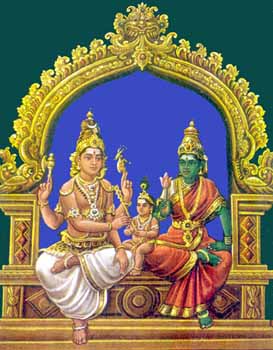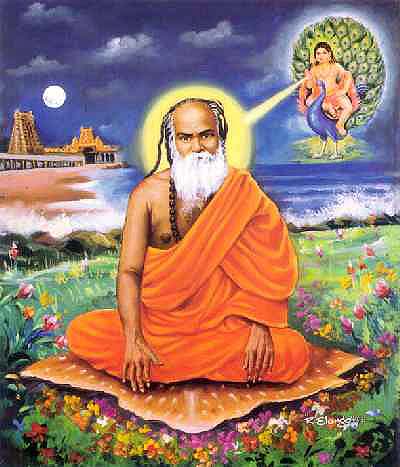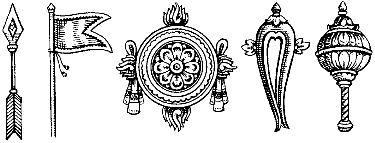
|
||||||||||||||||||||||||||||||||||
|
| ||||||||||||||||||||||||||||||||||
Shanmuka Kavacam and the Kavacam genreby S.P. SabharathnamTo make spiritual practice more effective and more fruitful, to be free from the thwarting and vailing impediments and forces and to keep perfect identity with the chosen deity, kavaca stotras -- amulet hymns -- were introduced in the realm of contemplative worship. This introduction took place even in the remotest past. Though there is evident presence of certain elements and aspects of kavaca stotra in the Atharva Veda, the kavaca stotras in their exact structural and compositional genre may be seen in the āgamas of Śaiva and Śākta traditions. It is learnt from the commentary of the Mrigendrāgama that Indra kept himself in perfect identity with the form of Nrisimha through the repeated recital of Nrsimha kavaca as instructed by Visņu and, being in that Nrisimha form, he received instructions on certain aspects of the Kāmikāgama from Lord Srīkaņtha1. The āgama revealed to Indra while he was incomplete identity with Mrigendra ('lion') came to be known as the Mrigendrāgama. This is the earliest references to the kavaca stotra as available from āgamic sources. The Nrisimha Kavaca as recited by Indra is not available now. Furthermore, it is noteworthy that Nrsimha, the deity of the kavaca stotra revealed to Indra by Visņu, is not to be taken as the Nrsimha incarnation of Visņu, just as the names Vāsudeva, Śankarsaņa, Aniruddha etc., occurring in the Sūrya Siddhānta of Maya are not to be taken to mean Visņu2. The manifestations of the Supreme Lord explained in the Śaivāgamas were undoubtedly prior to the stories of incarnations of Visņu and other gods as depicted in the Purāņas. Another important kavaca stotra of remotest time is the one known as Subramaņya Kavaca Stotra occurring in the Kumāra Tantra, one of the upāgamas of the Kāmikāgama. The Kumāra Tantra is the only āgama which exclusively and elaborately deals with the detailed process of daily worship of Lord Murukan, weekly and monthly festivals of Murukan temples, process of installation and consecration of various images related to Lord Murukan, grand festival, Mayūra Yajña and such other events. I. Following are the comprehensive and selective lists of kavaca stotras occurring in various sources such as tantras, kalpas and purāņas.
II. As revealed in the Chidambara Kalpa and the Ākāsha Bhairava Kalpa, we have four kavaca stotras, two on Lord Nateshvara and two on Daksināmūrti.
III. The purāņic works contain in themselves various
kavaca stotras dedicated to various deities:
IV. Kavaca stores occurring in various scriptures other than the original tantras and purāņas include:
V. Kavaca stotras available in Tamil as translated from the Sanskrit works.
VI. Kavaca stotras available in Tamil as original:
Devarāya Svāmigal's Kanta Casti Kavacam is dedicated to Lord Murukan of Tirucchendur. There are also shasti kavaca stotrams on Lord Murukan of Tirupparankundram, Palani, Svāmimalai, Tiruttaņi and Palamudircolai. But their authorship is yet to be determined. Compositional pattern of kavaca stotrasFrom a systematic analysis of the kavaca stotras, it may be observed that some kavaca stotras have been revealed by the divine Source directly to the competent devotee for the first time. Some have been instructed directly to the devotee as revealed earlier by the deity of the kavaca. There are some kavacas which have been revealed by the supreme source to the competent hearer (shrotru) as handed down in an unbroken lineage. There are only a few kavaca stotras, especially available in Tamil alone, which have been composed directly by the venerable saints themselves, as inspired by the divine grace from within. The best known example for this type of kavaca stotra is the Śanmuka Kavacam. Davarāya Svāmigal's Kanta Casti Kavacam is another example. Most of the kavaca stotras, as available in Sanskrit have identical compositional features. Each kavaca stotra is attributed to a particular rishi, chandas and devatā. Of these, rishi indicates a particular sage who first heard it, recited it, mastered it and attained siddhi (i.e. results) through the systematic recital of the kavaca; while chandas indicates the particular rhythmic style in which the stotra should be recited. Devatā denotes the deity invoked and eulogised in the stotra. Next follows the instruction on the exact process of kara nyāsa and anga nyāsa, by which the devotee or the spiritual practitioner is expected to mentally assume the form of the deity of the stotra, through the fixation of nyāsa mantras which constitute the form of the main duty, on certain parts of his own body. After the completion of nyāsa process, the sādhaka (spiritual practitioner) is expected to recite the dhyāna shloka, which is actually a rhythmic verse for deep meditation on the exact form of the deity. Dhyāna shlokas provide a full description of the form of deity, its face, hands, legs, etc. and of the various weapons and mudras being held by the deity. In this aspect, Śākta tantras are very much particular about the colour of the deity. The colour varies according to the intended purpose. After the recitation of dhyāna shloka, the aspirant should perform mentally five kinds of offering (Pañca Pūja), which are of the nature of five cosmic elements: earth, water, fire, air and space. Preceded by all these, the devotee should recite the kavaca stotra either one time or three times as instructed either in the earlier part (pūrva bhāga) or in the latter part (uttara bhāga). Upon the completion of the recital of kavaca, the devotee should repeat anga nyāsa, dhyāna shloka and pañca pūja, and complete the process by reading the concluding part in which the fruits of the systematic recital of kavaca are evidently detailed. In the kavaca stotra, the main deity is invoked through various names, each name signifying a particular aspect or attribute of the deity concerned. Each name is identified with each part of the recitor's body entreating protection of that particular part by the deity. The reciting devotee should maintain a triangular identity, while reciting the kavaca: identity between the deity and the cosmos; identity between the cosmos and the devotee; and identity between the devotee and the deity. The recitation of kavaca stotra would bear the desired fruits only upon the realization of such triangular identity. As far as the kavaca stotras available in Tamil are concerned, no such prior and posterior activities are recommended. The Tamil stotras allow devotees to commence the recital directly. But the maintenance of triangular identity as explained earlier is important even for the recitation of Tamil stotras.
Śanmuka KavacamThe Śamuka Kavacam, the most popular stotra among devotees of Lord Murukan, was composed by Saint Kumāragurudāsa Svāmigal, popularly known as Pāmban Svāmigal. He composed this in the year 1891, in order to free himself from the impending danger and the impeding difficulties and disturbances at that time. His efficacious composition yielded the desired result immediately. This stotra consists of thirty verses commencing from the first letter vowel and ending with the last consonant (twelve vowels and eighteen consonants make thirty). It is important to note that the number 12 and 18 are said to play dominant constructional roles in the whole of cosmic structure and in the designing of physical bodies. It is further said that the Tamil alphabet and certain ancient terms such as viņ , veli, kālam , etc., are directly related to cosmic science. According to the science of alphabets, as set forth in the Śaivagamas, the vowels and consonants constitute the aural form of the Supreme God, from head to feet. They also constitute the cosmic form. Every physical and subtle body therefore consists of vowels and consonants. Kavaca stotras of such type have been composed according to these conceptual principles. As explained in the āgamas, kavaca stotras are of two types - mantra vigraha kavaca and nāma vigraha kavaca. Mantra vigraha kavacas are composed by making use of the syllables of the mūla (fundamental) mantra of a particular deity. Nāma vigraha kavaca are composed by making use of the various significant names of the particular deity. The Śanmuka Kavacam belongs to the variety of nāma vigraha kavacas since as many as sixty-four significant names of Lord Murukan are mentioned. In many verses of this stotra, only Vēl, the matchless and invincible weapon of Lord Murukan, is invoked in the sense that Vēl is the inherent form of Lord Skanda or Murukan. Right from the day of its composition, Śanmuka Kavacam has wielded its enormous power of grace and protection. Many a time, it protected Pamban Svamigal himself. It was the continued recital of Śanmuka Kavacam done diligently by his devotee by name Subramaņyadāsar, that set right the fracture sustained by Pamban Svamigal. Many devotees have been saved from diverse difficulties and incurable diseases through the recital of Śanmuka Kavacam. Today there are millions of devotees of Murukan the world over for whom the Śanmuka Kavacam works out its miraculous power in triple way - as maņi, mantra and ausadha. A regular and systematic recital of kavaca stotra is very important for aspiring devotees. Such recital enable him to realise his state of perfect oneness with the Supreme Lord. Even for the recital of Tamil stotras, the ancient saints maintain that prior activities such as nyāsa, dhyāna and pañca pūja are necessary to derive the beatific effect. These should be known from perfect spiritual masters. Endnotes
Bibliography
Dr. S.P. Sabharathnam is Director of the Indian Institute of Indology in Chennai. Dr. Sabharathnarn is also Professor at Vastu Vedic Research Foundation and Associate Editor of Vastu Purusha. This paper was presented at the First International Conference Seminar on Skanda-Murukan, December 1998
|



